Spring Boot CRUD Operations
What is the CRUD operation?
The CRUD stands for Create, Read/Retrieve, Update, and Delete. These are the four basic functions of the persistence storage.
The CRUD operation can be defined as user interface conventions that allow view, search, and modify information through computer-based forms and reports. CRUD is data-oriented and the standardized use of HTTP action verbs. HTTP has a few important verbs.
- POST: Creates a new resource
- GET: Reads a resource
- PUT: Updates an existing resource
- DELETE: Deletes a resource
Within a database, each of these operations maps directly to a series of commands. However, their relationship with a RESTful API is slightly more complex.
Standard CRUD Operation
- CREATE Operation: It performs the INSERT statement to create a new record.
- READ Operation: It reads table records based on the input parameter.
- UPDATE Operation: It executes an update statement on the table. It is based on the input parameter.
- DELETE Operation: It deletes a specified row in the table. It is also based on the input parameter.
How CRUD Operations Works
CRUD operations are at the foundation of the most dynamic websites. Therefore, we should differentiate CRUD from the HTTP action verbs.
Suppose, if we want to create a new record, we should use HTTP action verb POST. To update a record, we should use the PUT verb. Similarly, if we want to delete a record, we should use the DELETE verb. Through CRUD operations, users and administrators have the right to retrieve, create, edit, and delete records online.
We have many options for executing CRUD operations. One of the most efficient choices is to create a set of stored procedures in SQL to execute operations.
The CRUD operations refer to all major functions that are implemented in relational database applications. Each letter of the CRUD can map to a SQL statement and HTTP methods.
| Operation | SQL | HTTP verbs | RESTful Web Service |
|---|---|---|---|
| Create | INSERT | PUT/POST | POST |
| Read | SELECT | GET | GET |
| Update | UPDATE | PUT/POST/PATCH | PUT |
| Delete | DELETE | DELETE | DELETE |
Spring Boot CrudRepository
Spring Boot provides an interface called CrudRepository that contains methods for CRUD operations. It is defined in the package org.springframework.data.repository. It extends the Spring Data Repository interface. It provides generic Crud operation on a repository. If we want to use CrudRepository in an application, we have to create an interface and extend the CrudRepository.
Syntax
where,
- T is the domain type that repository manages.
- ID is the type of the id of the entity that repository manages.
For example:
In the above example, we have created an interface named StudentRepository that extends CrudRepository. Where Student is the repository to manage, and Integer is the type of Id that is defined in the Student repository.
Spring Boot JpaRepository
JpaRepository provides JPA related methods such as flushing, persistence context, and deletes a record in a batch. It is defined in the package org.springframework.data.jpa.repository. JpaRepository extends both CrudRepository and PagingAndSortingRepository.
For example:
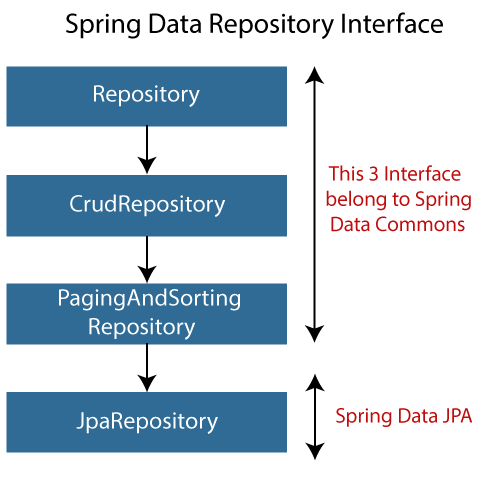
Why should we use these interfaces?
- The interfaces allow Spring to find the repository interface and create proxy objects for that.
- It provides methods that allow us to perform some common operations. We can also define custom methods as well.
CrudRepository vs. JpaRepository
| CrudRepository | JpaRepository |
|---|---|
| CrudRepository does not provide any method for pagination and sorting. | JpaRepository extends PagingAndSortingRepository. It provides all the methods for implementing the pagination. |
| It works as a marker interface. | JpaRepository extends both CrudRepository and PagingAndSortingRepository. |
| It provides CRUD function only. For example findById(), findAll(), etc. | It provides some extra methods along with the method of PagingAndSortingRepository and CrudRepository. For example, flush(), deleteInBatch(). |
| It is used when we do not need the functions provided by JpaRepository and PagingAndSortingRepository. | It is used when we want to implement pagination and sorting functionality in an application. |
Spring Boot CRUD Operation Example
Let’s set up a Spring Boot application and perform CRUD operation.
Step 1: Open Spring Initializr http://start.spring.io.
Step 2: Select the Spring Boot version 2.3.0.M1.
Step 2: Provide the Group name. We have provided com.tutoraspire.
Step 3: Provide the Artifact Id. We have provided spring-boot-crud-operation.
Step 5: Add the dependencies Spring Web, Spring Data JPA, and H2 Database.
Step 6: Click on the Generate button. When we click on the Generate button, it wraps the specifications in a Jar file and downloads it to the local system.
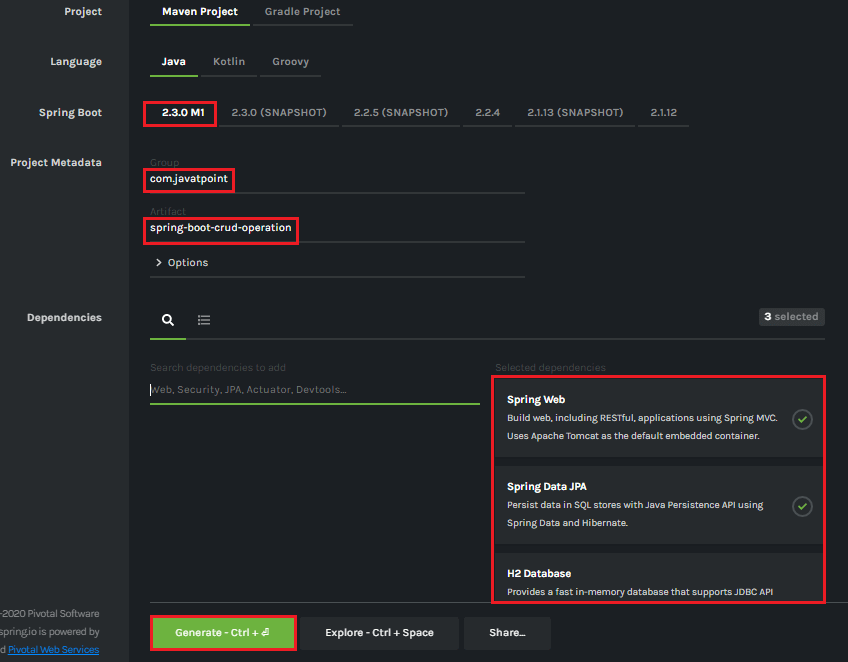
Step 7: Extract the Jar file and paste it into the STS workspace.
Step 8: Import the project folder into STS.
File -> Import -> Existing Maven Projects -> Browse -> Select the folder spring-boot-crud-operation -> Finish
It takes some time to import.
Step 9: Create a package with the name com.tutoraspire.model in the folder src/main/java.
Step 10: Create a model class in the package com.tutoraspire.model. We have created a model class with the name Books. In the Books class, we have done the following:
- Define four variable bookid, bookname, author, and
- Generate Getters and Setters.
Right-click on the file -> Source -> Generate Getters and Setters. - Mark the class as an Entity by using the annotation @Entity.
- Mark the class as Table name by using the annotation @Table.
- Define each variable as Column by using the annotation @Column.
Books.java
Step 11: Create a package with the name com.tutoraspire.controller in the folder src/main/java.
Step 12: Create a Controller class in the package com.tutoraspire.controller. We have created a controller class with the name BooksController. In the BooksController class, we have done the following:
- Mark the class as RestController by using the annotation @RestController.
- Autowire the BooksService class by using the annotation @Autowired.
- Define the following methods:
- getAllBooks(): It returns a List of all Books.
- getBooks(): It returns a book detail that we have specified in the path variable. We have passed bookid as an argument by using the annotation @PathVariable. The annotation indicates that a method parameter should be bound to a URI template variable.
- deleteBook(): It deletes a specific book that we have specified in the path variable.
- saveBook(): It saves the book detail. The annotation @RequestBody indicates that a method parameter should be bound to the body of the web request.
- update(): The method updates a record. We must specify the record in the body, which we want to update. To achieve the same, we have used the annotation @RequestBody.
BooksController.java
Step 13: Create a package with the name com.tutoraspire.service in the folder src/main/java.
Step 14: Create a Service class. We have created a service class with the name BooksService in the package com.tutoraspire.service.
BooksService.java
Step 15: Create a package with the name com.tutoraspire.repository in the folder src/main/java.
Step 16: Create a Repository interface. We have created a repository interface with the name BooksRepository in the package com.tutoraspire.repository. It extends the Crud Repository interface.
BooksRepository.java
Now we will configure the datasource URL, driver class name, username, and password, in the application.properties file.
Step 17: Open the application.properties file and configure the following properties.
application.properties
Note: Do not forget to enable the H2 console.
After creating all the classes and packages, the project directory looks like the following.
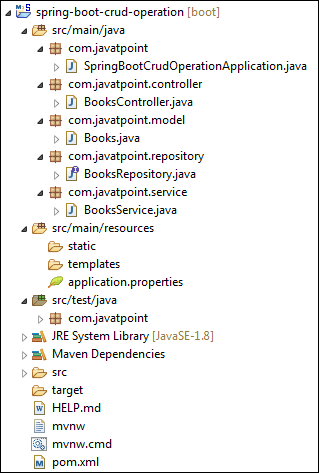
Now we will run the application.
Step 18: Open SpringBootCrudOperationApplication.java file and run it as Java Application.
SpringBootCrudOperationApplication.java
Note: In the next steps we will use rest client Postman. So, ensure that the Postman application is already installed in your system.
Step 19: Open the Postman and do the following:
- Select the POST
- Invoke the URL http://localhost:8080/books.
- Select the Body
- Select he Content-Type JSON (application/json).
- Insert the data. We have inserted the following data in the Body:
- Click on the Send
When the request is successfully executed, it shows the Status:200 OK. It means the record has been successfully inserted in the database.
Similarly, we have inserted the following data.
Let’s access the H2 console to see the data.
Step 20: Open the browser and invoke the URL http://localhost:8080/h2-console. Click on the Connect button, as shown below.
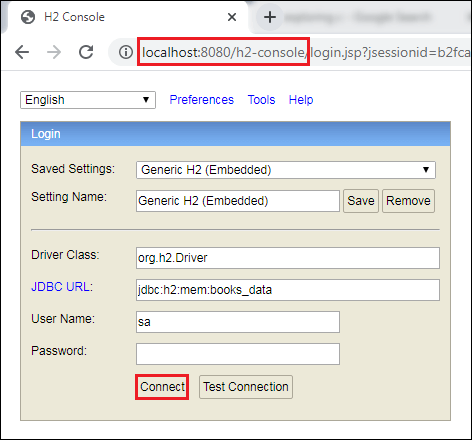
After clicking on the Connect button, we see the Books table in the database, as shown below.
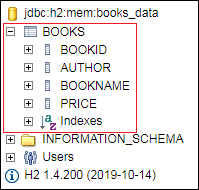
Step 21: Click on the Books table and then click on the Run button. The table shows the data that we have inserted in the body.
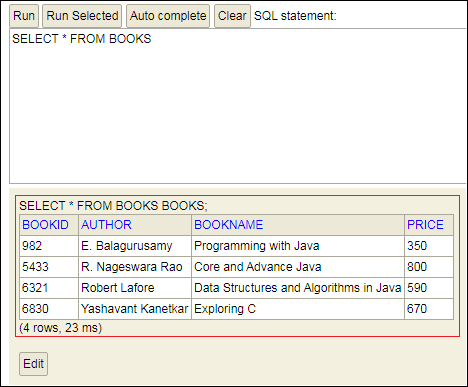
Step 22: Open the Postman and send a GET request with the URL http://localhost:8080/books. It returns the data that we have inserted in the database.
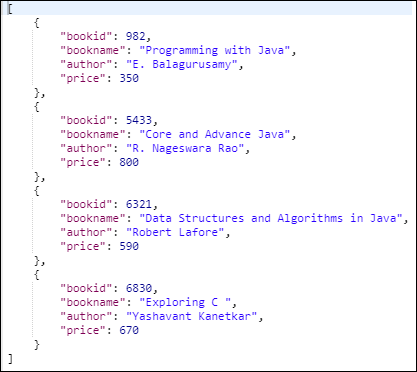
Let’s send a GET request with the URL http://localhost:8080/book/{bookid}. We have specified the bookid 6830. It returns the detail of the book whose id is 6830.
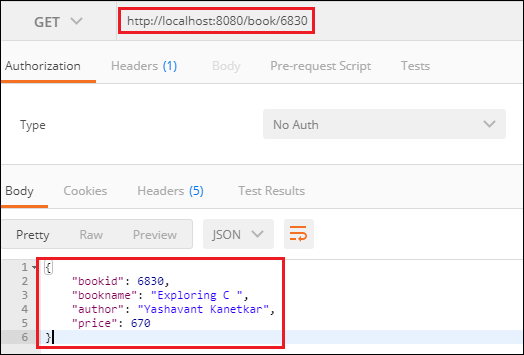
Similarly, we can also send a DELETE request to delete a record. Suppose we want to delete a book record whose id is 5433.
Select the DELETE method and invoke the URL http://localhost:8080/book/5433. Again, execute the Select query in the H2 console. We see that the book whose id is 5433 has been deleted from the database.

Similarly, we can also update a record by sending a PUT request. Let’s update the price of the book whose id is 6321.
- Select the PUT
- In the request body, paste the record which you want to update and make the changes. In our case, we want to update the record of the book whose id is 6321. In the following record, we have changed the price of the book.
- Click on the Send
Now, move to the H2 console and see the changes have reflected or not. We see that the price of the book has been changed, as shown below.

